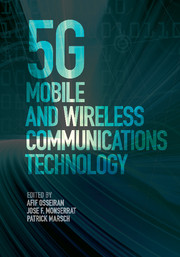Book contents
- Frontmatter
- Dedication
- Contents
- List of contributors
- Foreword
- Acknowledgments
- Acronyms
- 1 Introduction
- 2 5G use cases and system concept
- 3 The 5G architecture
- 4 Machine-type communications
- 5 Device-to-device (D2D) communications
- 6 Millimeter wave communications
- 7 The 5G radio-access technologies
- 8 Massive multiple-input multiple-output (MIMO) systems
- 9 Coordinated multi-point transmission in 5G
- 10 Relaying and wireless network coding
- 11 Interference management, mobility management, and dynamic reconfiguration
- 12 Spectrum
- 13 The 5G wireless propagation channel models
- 14 Simulation methodology
- Index
- References
13 - The 5G wireless propagation channel models
Published online by Cambridge University Press: 05 June 2016
- Frontmatter
- Dedication
- Contents
- List of contributors
- Foreword
- Acknowledgments
- Acronyms
- 1 Introduction
- 2 5G use cases and system concept
- 3 The 5G architecture
- 4 Machine-type communications
- 5 Device-to-device (D2D) communications
- 6 Millimeter wave communications
- 7 The 5G radio-access technologies
- 8 Massive multiple-input multiple-output (MIMO) systems
- 9 Coordinated multi-point transmission in 5G
- 10 Relaying and wireless network coding
- 11 Interference management, mobility management, and dynamic reconfiguration
- 12 Spectrum
- 13 The 5G wireless propagation channel models
- 14 Simulation methodology
- Index
- References
Summary
5G wireless propagation channel models are crucial for evaluation and comparison of the performance of different technology proposals, and for assessment of the overall performance of the foreseen 5G wireless system. This chapter elaborates on the main challenges of 5G channel modeling and describes the new proposed channel models.
Two different channel-modeling approaches, stochastic and map-based, are detailed. The purpose of the stochastic approach is to extend the traditional well-established WINNER [1] type of modeling for 5G. Some of the 5G requirements may however be hard to meet with stochastic modeling. For that reason, the map-based model, which is based on ray tracing, was also developed [2]. In order to parameterize and evaluate the models, extensive measurement campaigns have been conducted. The detailed description of the METIS channel models can be found in [2].
Introduction
The envisioned scenarios, use cases and concepts of 5G wireless communications, as described in Chapter 2, set new critical requirements for radio channel and propagation modeling. Some of the more important and fundamental requirements are the support of
• extremely wide frequency ranges from below 1 GHz up to 100 GHz,
• very wide bandwidths (> 500 MHz),
• full 3-dimensional and accurate polarization modeling,
• spatial consistency, i.e. the channel evolves smoothly without discontinuities when the transmitter and/or receiver moves or turns, for supporting highly dense scenarios,
• coexistence of different types of links in the same area such as cellular links with different cell sizes and Device-to-Device (D2D) connections,
• dual-end mobility, i.e. both link-ends move simultaneously and independently, for supporting D2D and Vehicle-to-Vehicle (V2V) connections as well as moving base stations,
• high spatial resolution and spherical waves for supporting very large antenna arrays, massive MIMO and beamforming,
• elevation extension for supporting 3D models and
• specular scattering characteristics especially for high frequencies.
Moreover, the model should provide spatially consistent characteristics for different topologies and between different users. Realistic small-scale fading, for example, would require multiple users to share a common set of scattering clusters.
Currently recognized and widely used channel models, like the 3GPP/3GPP2 Spatial Channel Model (SCM) [3], WINNER [1][4], ITU-R IMT-Advanced [5], 3GPP 3D-UMi and 3D-UMa [6], and IEEE 802.11ad [7], are found to be inadequate for 5G in that they do not meet these requirements [8].
- Type
- Chapter
- Information
- 5G Mobile and Wireless Communications Technology , pp. 357 - 380Publisher: Cambridge University PressPrint publication year: 2016



